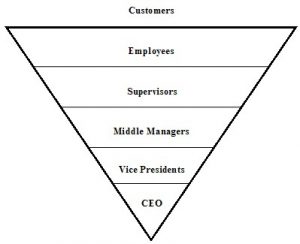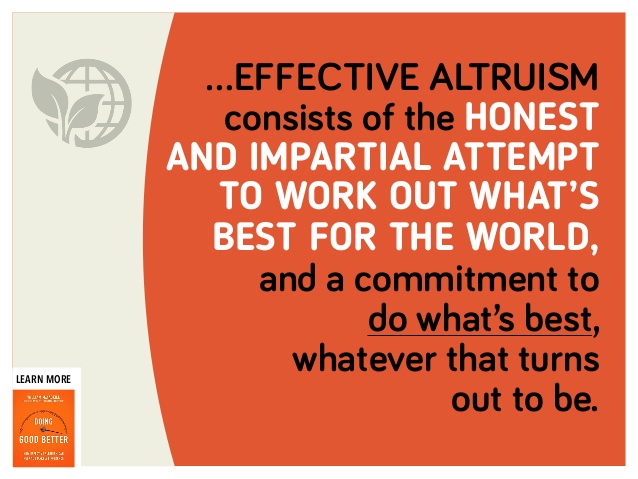
A flipped pyramid showing the structure of servant leadership (Haaff, 2015)
By: Greg Finkelstein, Kia Harris, and Jenny Shen, MNA ’18
In nonprofit entities, leadership is the cornerstone of success. Without good leadership, regardless of how impressive the individual components may be, productivity is far from maximized, and employees themselves may become marginalized. There are a plethora of leadership techniques which can be enacted at many levels, but their effectiveness varies depending on the environment in which they are employed. However, given the nature of nonprofits, servant leadership is the universal perfect match.
Servant leadership is a concept that many leaders will never be able to follow. They may feel that being a servant leader means that power is being yielded from them to other employees. This has nothing to do with servant leadership. A good leader can lead from the front, from behind, or from the side. Beyond that, a good servant leader is still clearly in charge. This concept does not mean that final authority shifts away from management and into the hands of the other employees.
To become a servant leader, one must have the mentality that their role is to support and address the needs of those who work under them (Johnson, 2017). Thinking from the employee’s perspective, checking in with them, and being receptive to feedback all give servant leaders insight on how to better facilitate the work being done. There are constantly new models or seminars on how to be a better leader, but what will always make sense is directly asking those who are being led how they want their situations improved.
The concept of servant leadership fits nonprofits perfectly because of both their virtues and shortcomings. Nonprofits usually have employees who truly want to be there and work towards the cause. Often, these employees are initially attracted to the organization because they align with the mission statement and the values emphasized. In this light, engaging in servant leadership is a very logical approach. Truly supporting those who have a high level of motivation to accomplish the organization’s mission and affinity for the cause at hand makes the most sense. If employees already want to work hard and efficiently, pushing and prodding them doesn’t help, but will instead wear people down over time. Supporting them, addressing their specific needs, and making the work environment as easy to maneuver as possible are the best ways to increase productivity when motivation is already high.
In addition to virtues, the shortcomings of nonprofits are another great reason to engage in servant leadership. Nonprofits may address a wide range of social issues, but they share many common challenges: being low on funds, having too few staff, and not having enough resources. Even large, multi-million dollar nonprofits have a limited ability to pay market rate wages. New nonprofits face these challenges and more, as their novelty and presumably small size makes them greatly vulnerable (Bielefeld, 2014). This gives the impression that nonprofits are at a disadvantage. Indeed, being at a disadvantage is far from anything new to nonprofits, but, rather, closer to the norm. Interestingly, there are significant drawbacks to relying on monetary reward as an incentive, as many for-profits do. Most importantly, it breeds fickle employees. Just like there is always a bigger fish, someone elsewhere will always be able to offer a bigger paycheck.
Clearly, nonprofits must rely on something more substantial than monetary reward. If an employee must accept that their work will not garner as many financial gains as compared to a similar position in the for-profit world, the last thing they want is to be led around by a totalitarian who doesn’t seem to respect their input and views them as replaceable commodities. Indeed, that would not be an easy environment to be in regardless of the sector. Additionally, nonprofit workers may be asked to go above and beyond their duties with no increase in tangible incentives. When this happens, knowing there is a leader who will do their best to address their employees’ needs is a great source of security and makes accepting the new obligations less daunting. The vanguard to overcoming these challenges can only be leadership, and servant leadership addresses these issues particularly well.
Servant leadership does not need to be the only management mechanism employed. Other models, ideas, and practices can blend well with servant leadership. For example, the 7 virtues of effective leaders, courage, integrity, humility, reverence, optimism, compassion, and justice, all fit perfectly under the frame of servant leadership (Johnson, 2017). If a leader views putting the needs of her or his staff as primary importance, they are then free to continue instilling motivation in a variety of ways. It is clear that embracing the unique traits and challenges of nonprofits is crucial to implementing good leadership. Servant leadership highlights these features, while empowering individuals to contribute as much as they can to something they believe in. It is no surprise, then, that this technique is rising in popularity.
 as Immediate Past-President – having served as President in 2016-17, now providing insight and best practices to NSC.
as Immediate Past-President – having served as President in 2016-17, now providing insight and best practices to NSC. ellle Risa Veslenio (right) has been appointed Part-Time Ambassador.
ellle Risa Veslenio (right) has been appointed Part-Time Ambassador.






